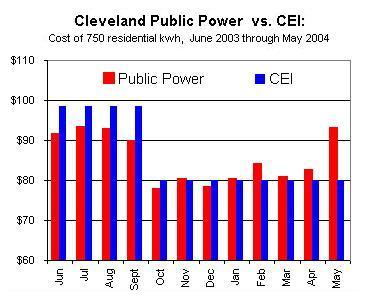Back in April I reported that Cleveland Public Power rates had actually exceeded CEI/First Energy rates for the first time in February. This should have been big news in Cleveland, because CPP still routinely claims that its customers have lower bills -- and because there's a whole chapter of recent Cleveland history devoted to the struggle to preserve "Muny Light" as a low-cost alternative to CEI.
My earlier comparison was based on CEI charges for a residential customer using 750 kilowatt-hours a month, according to the PUCO's monthly Utility Rate Surveys. At that time the PUCO surveys showed CEI's Winter bill for 750 kwh at $82.64. But that's changed; the PUCO now says the amount was really $80.08. Using that corrected figure, it seems that CPP charged more than CEI not just in February, but in November, January, March, April and May as well.

(Note: As you look at this graph, remember that CEI charges higher Summer rates for June, July, August and September. CPP has higher Summer rates in all four of those months plus May.)
Over the whole past year, the average CPP kilowatt hour for a 750-kwh household cost about 11.4 cents, compared to 11.5 cents charged by CEI. There was still a total "public power savings" for the whole year -- the princely sum of $10. But that "saving" doesn't factor in the "WPS" aggregation discount that the City provides to CEI households in Cleveland. Include that discount in the equation, and CPP's total year-round cost was higher than CEI's for Cleveland residents..
Of course, both local utilities are far more expensive than other municipal electric systems in Northeast Ohio -- not to mention the private utilities that profitably serve homes in Columbus, Dayton, Cincinnati, and the rest of southern Ohio for 7 to 9 cents a kilowatt-hour.
So when do you suppose this is going to become an issue for the Mayor and City Council?